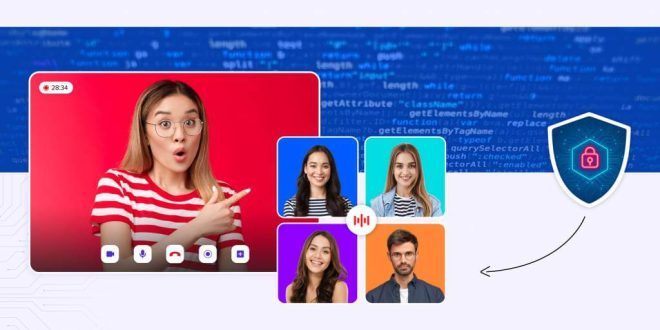Video conferencing applications are popular with businesses for communications and social interactions, today. The size of the video conferencing market was valued at USD 15 billion in 2020 and has grown to USD 75 billion by 2027 at a 23% CAGR.
This growth in the use of video-first communication is due to the rapid integration of artificial intelligence. Internet of Things (IoT) technologies make video conferencing very easy to use and a cost-effective communication alternative. However, these technologies also give rise to security issues. The answer to secure video conferencing features is WebRTC technology.
Let us learn more about how to have a secure video conferencing solutions using WebRTC technology…
Why is WebRTC technology best for your video conferencing solution?
Primarily, WebRTC technology removes the need for additional software or plugin since it can be launched from the browser and thus makes Web video conferencing very secure.
Secondly, any secure vulnerability can be discovered and fixed quicker when running on WebRTC rather than traditional application software. WebRTC components are updated whenever the browser software is updated. Currently, the rate to fix serious threats is within 24 hours of issues being discovered.
Hence, Video Conferencing SDK providers focus on the following security aspects:
Encryption – using standard secure protocols
- Secure data storage- using hashes and users’ passwords on the cloud
- Sessions security – using limited session time for users, sharing on workstations
- Securing Video conferencing rooms – Using advanced password-based access for meetings and other most secure video chats
- HDS certified platform supports all health use cases – used to accredit hosting of health data
Despite the software security protocols, users have to adopt safe use like the following…
6 Steps that secure your Video Conferencing solution
The advantages of interactive video software and collaboration applications can be beneficial only when users do not risk their data. The following six steps will allow you to keep your information safe and enhance your user experience:
Network Security: Primary Need
In the process to secure your video conferences you will have to ensure that all the devices that participate over the network are safe. Secondly, the network itself has to be secured by customized firewalls and encrypted passwords.
Evaluate your video conferencing system
As is the norm, with age video conferencing systems too will become susceptible. Hence, the standard procedure is to assess systems for possible security risks every five years. The areas that need special focus in such evaluations are data management, user access processes, and encryption capacities. After assessing where necessary updates and total replacement should ensure the protection of high standards.
Use only new passwords
While setting up network equipment for conferencing or updating it, take all necessary precautions to secure the logins. Resist the temptation to use default passwords and settings to hasten the installing process. These are the very vulnerabilities cybercriminals will exploit to capture sensitive, company-owned proprietary information.
Industry reports point out that the cybercrimes average $6 trillion each year, and securing digitized business assets of organizations is a very big challenge. Hence, the proper practice is to establish individual user names for every participant and create passphrases to log-off video conference sessions.
Strengthen user policy
It is very important that across the organization there are consistent practices in how the video conferencing assets are used. This can be controlled by setting up a user policy so that multiple people and multiple locations do not create loopholes to easily access the application. Latest mobile technology makes it possible to send and receive high-quality video on smartphones, tablets, and computers. Invest in a full-fledged user policy for safe use. Even when participants use their own devices, the expectations and boundaries have to be secured. The policy should clearly state the proper use such as password length, and privacy protection when using the conferencing features.
User Training
The important step to keep corporate secure video conferencing to begin with safe training users. This is a critical step especially when remote users are participating. Ideally, a step-by-step training video will be effective as users can access it whenever it is needed. Fresh users or existing users needing a refresh on the processes can use the video at their own pace. To be effective, the video has to be a clear presentation with no unnecessary technical jargon.
SSO and 2FA were most important
When considering user access options, it is necessary that network administrators reduce the potential confusion by using Single-Sign-on (SSO) and two factors Authentication (2FA). This will help mitigate potential delays caused by user log-ins and track likely harmful activities or practices using other user profiles.
Conclusion
Leading video conferencing solution providers offer advanced AI-driven features like resolution upscaling, acoustic fencing, active participant frame, active noise cancellation, facial recognition, proximity detection and automated note-taking abilities. Though these features make video conferencing an excellent application, they also involve intense data exchange leading to security vulnerabilities. WebRTC technologies are currently the most secured video conferencing solution available. Always choose a video conference API that runs on WebRTC and secure your client communications. Know more about special pricing packages if you are a single user, multi-user, or enterprise user.
 Posting Point
Posting Point

